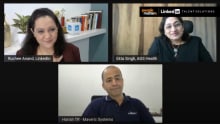The Great Reshuffle: Challenges, opportunities and the road ahead
One HR Read similar articles

The past two years have ushered dramatic shifts in the ways of working. As the world bounces back from another wave of the COVID19 pandemic, employee choice, flexibility, employee wellbeing, benefits, empathy-led leadership are becoming entrenched among organisations. As companies navigate these organisational norms in an increasingly hybrid environment, they need to understand employee needs better.
What talent wants in a hybrid environment
Employee expectations around hybrid working have evolved. On the one hand, we see the "hybrid paradox", with 70 per cent of people wanting human connection back. Secondly, meaning and purpose are not just about when, where, and how people want to work. It is also about "why they work."
Ryan Roslansky, the CEO of LinkedIn, points to how multiple choices are at the core of organisational working today. While CEO-leadership teams are trying to figure out how their company looks and functions, i.e., hybrid or remote, much of the decision stems from employees working differently over the last two years. Leaders need to ensure that people's values align with their employers' values, allowing for increased flexibility and better efficiency and effectiveness.
Flexibility and the future
LinkedIn's Global Talent Trends Report 2022 shows that employees are 2.6x more likely to be happy when they have time and location flexibility. And they're 2.1x more likely to recommend working for the company.
According to the study, flexibility is vital for a new generation of employees - Especially Generation Z, whose engagement increased by 77 per cent on LinkedIn posts mentioning flexibility and Millennials, whose engagement rose by 30 per cent on the same posts.
There are two extreme approaches that organisations are considering, one providing complete flexibility and moving to 100 per cent work from anywhere, the other being moving back to the office without any flexibility, said Chetan Yadav, Chief People Officer, Tally Solutions.
"It is imperative that the organisations and leaders do not get swayed away by either extreme. They need to decide based on the nature of work, collaborative efforts required and employee expectations. This might not necessarily be homogenous across the organisation and can vary irrespective of the team size," he added.
Echoing a similar sentiment, Anu Mathew, Chief People Officer, Pine Labs, said, "Just as every business captures feedback from its customers, it's equally important to truly listen and involve your people in decisions that impact their lives and eventually contribute towards the success of the organisation,"
At Pine Labs, employees are encouraged to integrate human connections and technology tools to listen and co-create new ways to evolve with the changing times.
People and organisations face several choices around building the workplace and workways, such as 'being together versus being remote', 'being synchronous versus asynchronous' etc. Organisations must build data expertise as an organisational capability to help people exercise the flexibility they need to be their productive best.
Companies need to establish guidelines for working with remote workers, create a level playing field for all employees and ensure employee bond with virtual events. And managers need to discern what, where and how flexibility is necessary.
Wellbeing as a differentiator
Another key factor at the centre of the talent agendas is wellbeing. LinkedIn's research showed that if employees feel cared for at work, they are 3.2x more likely to be happy at work. And they're 3.7x more likely to recommend working for the company.
There's a 73 per cent increase in companies talking about wellbeing since 2019. And a 147 per cent increase in the share of job posts that mention wellbeing since 2019. Women are 41 per cent more likely to engage with wellbeing company posts than the average post.
Gen Z wants a workplace culture built on mental health and wellness. About 66 per cent of Gen Z said they'd like to see more investment in mental health and wellness to improve company culture. About 51 per cent of Millennials said the same.
In keeping with these trends, "over the last two years, Tally Solutions extended in-person professional counsellors whom employees can engage with and seek guidance. Additionally, sessions from renowned doctors and virtual fitness programs through leading fitness companies have helped keep employees engaged. The company also has a continuous engagement mechanism to listen to employees and address their concerns, be it related to work or health," Chetan said.
At Pine Labs, the most successful wellness program had been a quarterly health challenge. "Every quarter, 1000 people signed up to achieve a health goal. Announced most recently is the '21 days Healthy Habits Challenge' where each senior leader selected a health challenge and drove people to start a new healthy habit. "The senior leadership played a key role in building this health-first culture by both participating actively and getting all teams involved," Anu noted.
Every leader needs to think holistically about how to take care of their own and their teams' wellbeing, enhance their contribution, and stay connected with the company's mission while fostering their career progress.
Culture as a selling point
Preparing for lasting transformation needs a shift in organisational culture.
The great reshuffle has highlighted that culture can be a selling point for picky job seekers. A study of users on LinkedIn revealed that there is a 2x increase in job posts viewed per application in 2021 compared to 2019. And there's a 67 per cent increase in engagement when company posts mention culture.
Recounting Tally's approach, Chetan notes that the company "has a culture based on Care, Trust and Development in general and a strong tech focus in the way of working because of the niche technology that the business operates in. The company communicates these aspects during recruitment, so it helps the candidate make the right decision."
Apart from the hiring stage, there are several tactics that companies can use to listen to their employees. They also need to be willing to change the messaging, get leaders talking about workplace culture and engage in audit practices to ensure no gap between the culture within and the employer value proposition outside.
The Great Reshuffle has led to multiple competing talent management priorities. Leaders need to step up to create and keep up the connection between people, mission, and company. In a hybrid environment, people desire flexibility, but managers need to be closely in touch with the people they lead to discerning that flexibility. Leaders must be present, have compassion and empathy, build trust, and care for their people. Care is the new currency and will help leaders create a new management framework that is win-win for employers and employees.






